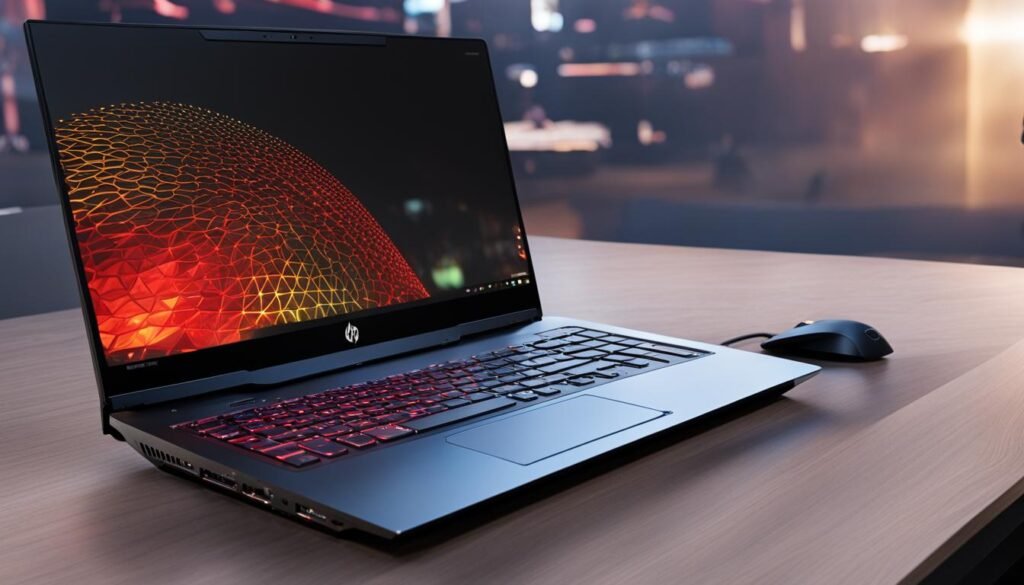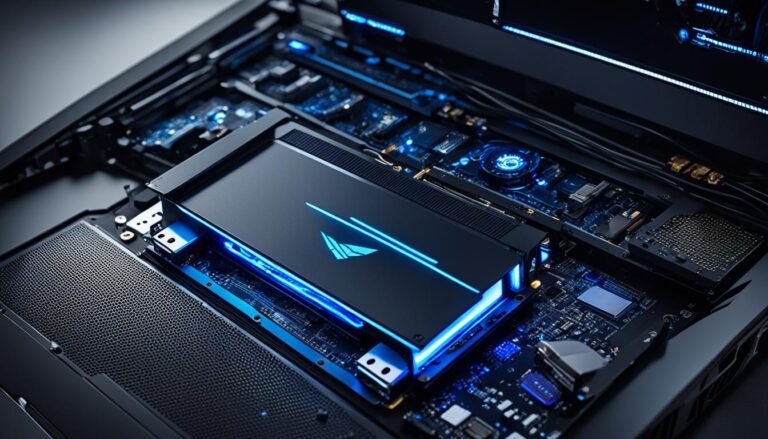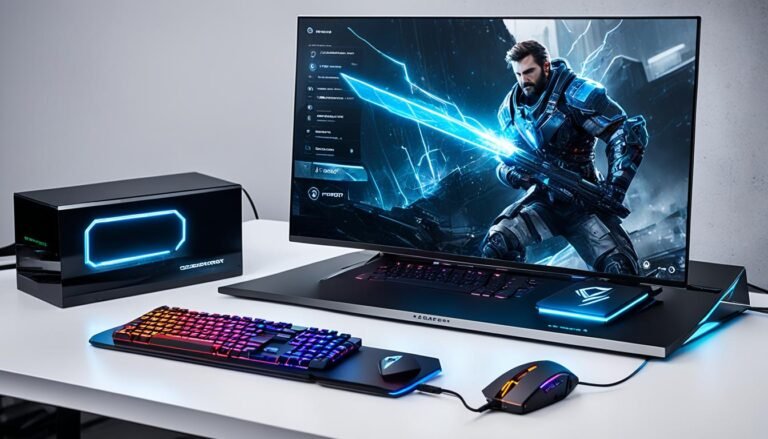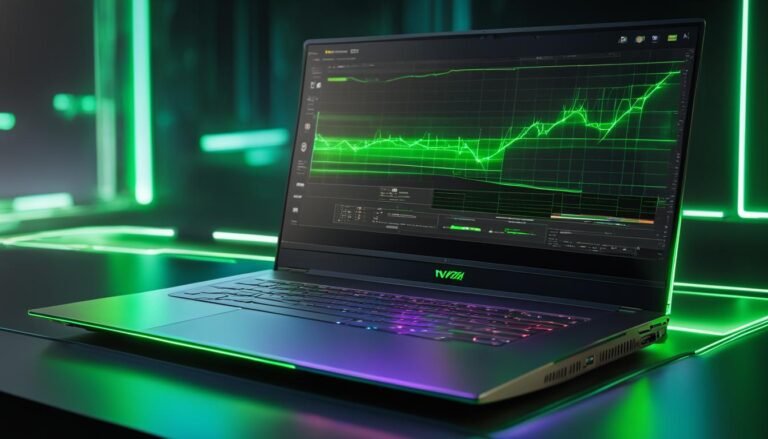Upgrade with External GPU for HP Laptop | Peak Performance
High-quality graphics are essential for gamers and creative professionals to have the best experience and performance. An external GPU, also known as an eGPU, is a new technology that allows laptop users to achieve desktop-quality graphics by connecting an external hardware dock. It can transform the visual experience for gaming and can also be used for video and graphics editing. It’s important to research before upgrading your graphics to ensure compatibility with your HP laptop.
Key Takeaways:
- An external GPU enhances graphics performance on an HP laptop, providing desktop-like quality.
- Research compatibility and choose the best external GPU option for your specific HP laptop model.
- External GPUs are beneficial for gaming, video editing, and other graphics-intensive tasks.
- Ensure your HP laptop has a Thunderbolt 3 port for compatibility with most eGPU options.
- Follow proper setup procedures and troubleshoot common issues for optimal performance.
How do eGPUs work?
Laptop computers are often limited in terms of graphics processing power compared to desktop computers. This can result in lower image quality and performance, especially when it comes to demanding tasks such as gaming and graphic-intensive applications. However, with the introduction of external GPUs (eGPUs), laptop users can now enjoy desktop-quality graphics and enhance their gaming experience.
An eGPU is a technology that combines a desktop-style power supply, a powerful graphics card, and a PCIe connection. This external hardware dock connects to the laptop, allowing it to retrieve graphics processing power from the eGPU instead of relying solely on the laptop’s built-in graphics card. The eGPU works in tandem with the laptop’s existing hardware, enhancing the graphics performance and providing a significant boost in gaming and image rendering capabilities.
This powerful combination of the laptop and the external GPU allows users to experience desktop-quality graphics on their laptops, surpassing the limitations of the laptop’s internal graphics processing power. Whether it’s playing the latest games at high settings or working on graphics-intensive projects, an eGPU can significantly enhance the laptop’s capabilities and provide a more immersive gaming experience or improve the overall quality of graphics processing for creative professionals.
External GPUs are not limited to laptops. They can also be used to enhance the performance of desktop computers, especially for users who require additional graphics processing power for demanding tasks. However, they are commonly associated with laptops due to their portability and the ability to transform a standard laptop into a powerful gaming or graphics processing machine.
Laptop graphics processing power vs. eGPUs
Laptops typically feature integrated graphics cards that are designed to balance performance and energy efficiency. While they are suitable for everyday tasks like web browsing and office productivity, they are often insufficient for running graphically demanding games or applications at high settings. On the other hand, eGPUs offer a desktop-level graphics processing power that can handle the demanding requirements of modern gaming and creative work.
An eGPU connects to the laptop via a fast PCIe connection, bypassing the limitations of the laptop’s internal graphics card and utilizing the power of the external GPU. This combination significantly improves the laptop’s graphics processing capabilities, resulting in better image quality, smoother gameplay, and faster rendering times.
The gaming experience with eGPUs
Gaming enthusiasts can benefit greatly from using an eGPU with their laptops. By connecting an external GPU, they can enjoy a more immersive gaming experience with higher frame rates, sharper visuals, and improved texture details. Games that previously struggled to run smoothly on a laptop can now be played with ease, maximizing the enjoyment of the gaming experience.
Additionally, eGPUs provide the flexibility to upgrade the graphics processing power of a laptop without having to entirely replace the machine. This makes it a cost-effective option for gamers who want to keep their existing laptop but desire better gaming performance.
With the combination of an eGPU and a compatible laptop, gamers can achieve desktop-level graphics performance and take their gaming experience to new heights.
| eGPUs for HP Laptops | Compatibility | Graphics Performance |
|---|---|---|
| HP OMEN Accelerator | Compatible with Thunderbolt 3 | Supports powerful graphics cards for enhanced gaming performance |
| Razer Core X | Compatible with Thunderbolt 3 | Offers desktop-level graphics performance for gaming and creative work |
| ASUS ROG XG Station 2 | Compatible with USB Type-C and Thunderbolt 3 | Delivers high-performance graphics for gaming and professional applications |
Benefits of connecting an external GPU
Investing in an external GPU offers numerous benefits for HP laptop users, allowing them to enhance their graphics performance without the need to purchase a new PC. This is especially advantageous for addressing the limitations of aging internal graphics technology found in most laptops.
One of the key advantages of connecting an external GPU is the ability to enjoy powerful graphics processing capabilities. Unlike integrated laptop graphics, an external GPU provides desktop-level performance, resulting in improved image quality and smoother gameplay for gamers, as well as accelerated video editing and graphics rendering capabilities for creative professionals.
Another significant benefit is the potential for cost-saving. Instead of investing in an entirely new computer system, users can simply add an external GPU to their existing HP laptop, allowing them to upgrade their graphics capabilities at a fraction of the cost.
Furthermore, using an external GPU maintains the versatility of a laptop as both a gaming device and an everyday computer. Users can easily detach the external GPU when not needed, restoring their laptop’s portability and convenience.
Feature Comparison Table – Internal Graphics vs. External GPU
| Features | Internal Graphics | External GPU |
|---|---|---|
| Graphics Processing Power | Limited | Desktop-level performance |
| Image Quality | Lower quality | Enhanced graphics quality |
| Gameplay Smoothness | Lower FPS, occasional lag | Higher FPS, smoother gameplay |
| Video Editing Capabilities | Basic editing capability | Accelerated rendering, better editing capabilities |
| Cost | Included in laptop cost | Cost-effective upgrade option |
| Versatility | Single purpose | Can be detached, maintains laptop’s portability |
By connecting an external GPU, HP laptop users can unlock the full potential of their graphics capabilities, enjoying powerful graphics processing, cost-saving benefits, and the versatility of a laptop that caters to both gaming and everyday computing needs.
Is my laptop eGPU compatible?
When considering upgrading your HP laptop with an external GPU, it’s important to determine if your laptop is compatible. The compatibility of your laptop with an external GPU depends on several factors, including the availability of a Thunderbolt 3 port and graphics card compatibility.
Most eGPU docks in the market require a Thunderbolt 3 port for connection. Thunderbolt 3 is a high-speed input/output port that enables accelerated graphics communication between the laptop and the eGPU. It has become the industry standard for eGPU compatibility due to its fast data transfer rates and ability to deliver desktop-like graphics performance.
Before investing in an eGPU, check if your HP laptop has a Thunderbolt 3 port. This can usually be identified by its distinctive lightning bolt symbol. If your laptop doesn’t have a Thunderbolt 3 port, it may not be compatible with most eGPU options available.
In addition to the Thunderbolt 3 port, another important consideration is the compatibility of the graphics card you intend to use with your laptop. Different eGPU enclosures support specific graphics cards, so it’s crucial to ensure that the graphics card you choose is compatible with the eGPU enclosure and your laptop.
To summarize, before purchasing an eGPU for your HP laptop, check for the presence of a Thunderbolt 3 port and ensure compatibility with the graphics card you intend to use. This will ensure a smooth and successful integration of the external GPU with your laptop, allowing you to enjoy enhanced graphics performance for gaming, video editing, and other graphics-intensive tasks.

| HP Laptop Model | Thunderbolt 3 Port | Graphics Card Compatibility |
|---|---|---|
| HP Spectre x360 | Yes | Nvidia GeForce GTX 10 series |
| HP Pavilion Gaming Laptop | No | N/A |
| HP OMEN 15 | Yes | AMD Radeon RX 5000 series |
How to choose an external GPU
When upgrading your HP laptop with an external GPU, it’s essential to consider several key characteristics to ensure compatibility and optimize performance. These characteristics include:
- PSU max power: Ensure that the power supply unit (PSU) of the external GPU has sufficient power for visually-intensive games and graphics-intensive tasks.
- PSU type location: Consider the location of the PSU in the external GPU enclosure, as it affects the cooling system. An efficient cooling system is crucial to prevent overheating and maintain stable performance.
- Size: Choose an external GPU that fits your gaming setup and workspace. Consider the dimensions of the enclosure and the available space for seamless integration.
- Compatibility with laptop connection: Preferably, select an external GPU that is compatible with your laptop’s connection, particularly if your laptop has a Thunderbolt 3 port. Thunderbolt 3 provides high-speed data transfer and is a popular choice for eGPU connectivity.
- Compatibility with graphics card: Ensure that the external GPU is compatible with the graphics card of your choice. Whether you opt for a pre-installed graphics card or plan to install a graphics card separately, verify the compatibility to avoid compatibility issues.
Consider these characteristics when comparing different external GPU options to find the best fit for your HP laptop. By carefully evaluating these specifications, you can enhance your laptop’s graphics capabilities and achieve optimal performance for gaming or graphics-intensive tasks.
How to set up an external GPU
If you’re looking to upgrade your laptop’s graphics performance, setting up an external GPU can be a game-changer. With the right equipment and proper installation, you can enjoy enhanced visuals and improved gaming experiences. Here’s a step-by-step guide to help you get started with your external GPU setup.
Gather the necessary equipment
To set up an external GPU, you’ll need the following:
- An eGPU enclosure
- A compatible laptop
- A display monitor
- A Thunderbolt 3 connection
- A video graphics card
- A power supply
One popular eGPU enclosure option is the HP OMEN Accelerator, renowned for its high-performance capabilities.
Install the software
Before connecting your eGPU, make sure to install the necessary software provided by the manufacturer. This software ensures smooth communication between your laptop and the external graphics card.
Connect the power supply and display monitor
Connect the power supply to the eGPU enclosure, ensuring it is securely plugged in. Next, connect your display monitor to the eGPU enclosure using the appropriate cables.
Establish the Thunderbolt connection
Use a Thunderbolt 3 cable to establish a connection between the eGPU enclosure and your laptop. This high-speed connection allows for data transfer between the two devices and ensures a seamless graphics experience.
Additional steps
Depending on the specific eGPU enclosure you’re using, there may be additional steps required. Refer to the manufacturer’s instructions for any additional setup requirements or software configurations.
Setting up an external GPU can significantly enhance your laptop’s graphics performance, taking your gaming and graphics-intensive tasks to new heights. By following these steps and using quality hardware like the HP OMEN Accelerator, you’ll be well on your way to a top-notch external GPU setup.
How to choose the right eGPU for your HP laptop
When considering an external GPU (eGPU) for your HP laptop, it’s important to take into account several factors to ensure compatibility, meet your performance requirements, and make an informed decision based on user reviews. By researching different models and their specifications, you can choose the right eGPU that best fits your needs.
Compatibility is key when selecting an eGPU for your HP laptop. Check if the specific model of your laptop is compatible with the eGPU you’re interested in. Some laptops have limitations or restrictions regarding eGPU connections, so it’s essential to verify compatibility to avoid any issues during setup.
Performance requirements are another crucial aspect to consider. Determine the specific games or applications you plan to use with the eGPU and check the recommended system requirements for those programs. This will help you gauge the level of performance you need from the external graphics card.
Reading user reviews can provide valuable insights into the experiences of others who have already used the eGPU you’re considering. Look for reviews from users who have the same laptop model as you, as they can provide more relevant feedback. Pay attention to aspects such as ease of setup, stability, and overall performance.
An eGPU can significantly enhance the graphics performance of your HP laptop, delivering desktop-like performance. By choosing the right eGPU, ensuring compatibility with your laptop, meeting your performance requirements, and considering user reviews, you can make a well-informed decision that will elevate your gaming and creative experiences.
Common issues with eGPU setup and how to troubleshoot
While setting up an external GPU (eGPU) can greatly enhance graphics performance on your HP laptop, it’s not uncommon to encounter some issues during the setup process. This section will address some common problems and provide troubleshooting solutions to help you overcome them.
1. Thunderbolt Security Settings
One of the issues you may encounter is the eGPU not being recognized due to Thunderbolt security settings. To resolve this problem, follow these steps:
- Restart your laptop and enter the BIOS settings.
- Find the Thunderbolt security settings and set them to allow the eGPU connection.
- Save the changes and exit the BIOS settings.
2. Driver Installation Problems
Another common issue is driver installation problems. To ensure smooth driver installation, follow these steps:
- Visit the manufacturer’s website and download the latest driver for your eGPU model.
- Disconnect the eGPU from your laptop.
- Uninstall any existing eGPU drivers from your laptop.
- Restart your laptop.
- Install the downloaded driver.
- Reconnect the eGPU to your laptop.
3. Hardware Compatibility Issues
Hardware compatibility can also be an issue when setting up an eGPU. To ensure compatibility, consider the following:
- Check the compatibility list of your eGPU model to ensure it is compatible with your HP laptop.
- Verify that your laptop has a Thunderbolt 3 port, as most eGPU setups require this interface.
- Ensure that your laptop’s power supply can handle the additional power requirements of the eGPU.
- Ensure that the graphics card you plan to use with the eGPU is compatible with the eGPU enclosure.

By addressing these common issues with eGPU setup, you can ensure a smooth and successful upgrade to enhance your HP laptop’s graphics performance.
Tips for optimal performance with an external GPU
When using an external GPU (eGPU), there are several key factors to consider in order to achieve optimal performance. Whether you’re a gamer or a creative professional seeking enhanced graphics capabilities, implementing these tips will help you make the most of your eGPU setup.
Regularly Update Your Drivers
Keeping your drivers up to date is crucial for ensuring compatibility and maximizing performance with your eGPU. Graphics card manufacturers often release driver updates that include bug fixes, performance optimizations, and new features. By regularly checking for and installing the latest drivers, you can stay on top of any improvements that will enhance your eGPU’s performance.
Ensure Proper Cooling for the eGPU Enclosure
Effective cooling is essential for maintaining optimal performance and preventing overheating. Many eGPU enclosures come with built-in cooling systems, such as fans and ventilation, to dissipate heat generated by the powerful graphics card. Make sure to position your eGPU enclosure in a well-ventilated area, free from obstructions that could impede airflow. Additionally, consider using cooling pads or external fans to further assist in keeping your eGPU cool during intense gaming sessions or resource-intensive tasks.
Manage Power Settings to Maximize Performance
To get the most out of your eGPU, it’s important to manage power settings effectively. Adjusting power management options can help ensure that your eGPU is operating at optimum performance levels. In most cases, setting your laptop and eGPU to “High Performance” mode will prioritize performance over power saving, enabling the eGPU to deliver maximum graphics processing power.
Adjust Graphics Settings in Games or Applications
One of the key advantages of an eGPU is its ability to handle higher graphics settings in games and applications. To take full advantage of this capability, make sure to adjust the graphics settings in your preferred games or applications accordingly. Increase the quality settings, resolution, and other visual options to fully exploit the potential of your eGPU, granting you a more immersive and visually stunning experience.
“By following these tips, you can optimize the performance of your eGPU and unlock its full potential. With regular driver updates, proper cooling, power management, and graphics settings adjustments, you’ll experience a significant boost in graphics performance and enjoy a smoother and more immersive gaming or creative work experience.”
Conclusion
Upgrading your HP laptop with an external GPU can have a profound impact on your gaming and creative work. With the right eGPU and proper setup, you can enjoy enhanced graphics performance, bringing desktop-quality visuals to your laptop. Whether you’re a passionate gamer or a professional involved in creative work, the benefits of an eGPU are undeniable.
By investing in an eGPU, you can transform your laptop into a powerful gaming machine or a high-performance workstation for graphic design, video editing, and other creative endeavors. Not only does this upgrade enhance your overall experience, but it also saves you the significant cost of purchasing a new computer.
Furthermore, using an eGPU allows you to maintain the versatility of your laptop. You can effortlessly switch from intense gaming sessions to everyday computing tasks without compromising on performance. The ability to enjoy immersive gameplay and complete creative projects on the go makes the eGPU a game-changer for many professionals and enthusiasts.
Before making the decision to upgrade, it’s crucial to research and ensure compatibility between your HP laptop and the chosen eGPU. Consider factors such as your laptop model, performance requirements, and user reviews. By carefully selecting an eGPU that meets your specific needs, you can truly unlock the full potential of your HP laptop and enjoy the enhanced graphics performance it offers.
FAQ
How do eGPUs work?
eGPUs, or external GPUs, enhance laptop graphics by connecting to an external hardware dock. This dock combines a desktop-style power supply, a powerful graphics card, and a PCIe connection. The laptop can then retrieve graphics from the external dock, resulting in improved image quality and performance.
What are the benefits of connecting an external GPU?
Connecting an external GPU to your HP laptop allows you to upgrade your graphics without buying a new PC. This is particularly advantageous for addressing aging internal graphics technology. It provides powerful graphics processing for gaming and creative work, saves on cost, and maintains the versatility of a laptop as both a gaming device and an everyday computer.
Is my laptop eGPU compatible?
Not all laptops are compatible with eGPUs. Most eGPU docks require a Thunderbolt 3 port for connection, as it is the industry standard. It is crucial to check if your HP laptop has a Thunderbolt 3 port before considering an eGPU upgrade. Additionally, make sure your chosen eGPU is compatible with the graphics card you want to use.
How do I choose an external GPU?
When choosing an eGPU, consider characteristics like PSU max power, PSU type location, size, compatibility with your laptop’s connection (preferably Thunderbolt 3), and compatibility with your preferred graphics card. Research different eGPU models, their specifications, and user reviews to find the best fit for your specific needs.
How do I set up an external GPU on my HP laptop?
To set up an eGPU, you will need an eGPU enclosure, a laptop, a display monitor, a Thunderbolt 3 connection, a video graphics card, and a power supply. One popular eGPU enclosure option is the HP OMEN Accelerator. The specific setup steps may vary depending on the chosen eGPU enclosure, but generally involve installing software, connecting the power supply and display monitor, and establishing the Thunderbolt connection between the dock and laptop.
How do I choose the right eGPU for my HP laptop?
When choosing an eGPU for your HP laptop, consider factors such as compatibility with your specific laptop model, performance requirements for your games or applications, and user reviews of different eGPU options. Research different models and their specifications to find the best eGPU that meets your needs for optimal performance.
What are common issues with eGPU setup and how can I troubleshoot them?
Common issues with eGPU setup include Thunderbolt security settings preventing recognition, driver installation problems, and hardware compatibility issues. To troubleshoot these issues, ensure Thunderbolt security settings are properly configured, install the correct drivers for your eGPU, and verify hardware compatibility between all components.
What are some tips for optimal performance with an external GPU?
To achieve optimal performance with an eGPU, regularly update your drivers, ensure proper cooling for the eGPU enclosure, manage power settings to maximize performance, and adjust graphics settings in games or applications to take full advantage of the eGPU capabilities.
What are the benefits of using an external GPU with my HP laptop?
Upgrading your HP laptop with an external GPU significantly enhances graphics performance for gaming and creative work. With the right eGPU and proper setup, you can achieve desktop-quality graphics on your laptop, saving cost and maintaining the versatility of your laptop as both a gaming device and an everyday computer.





